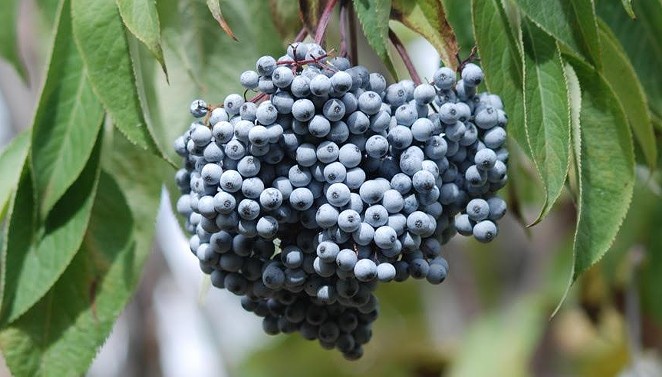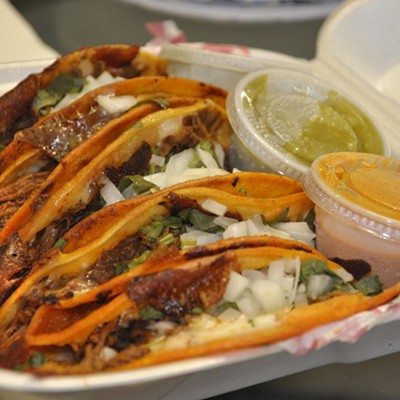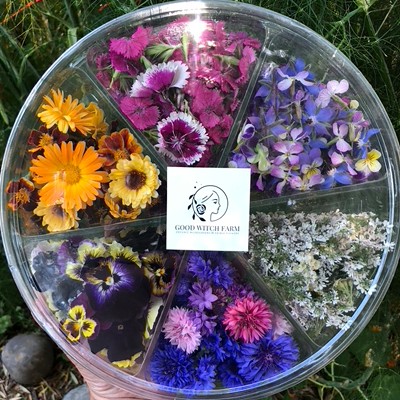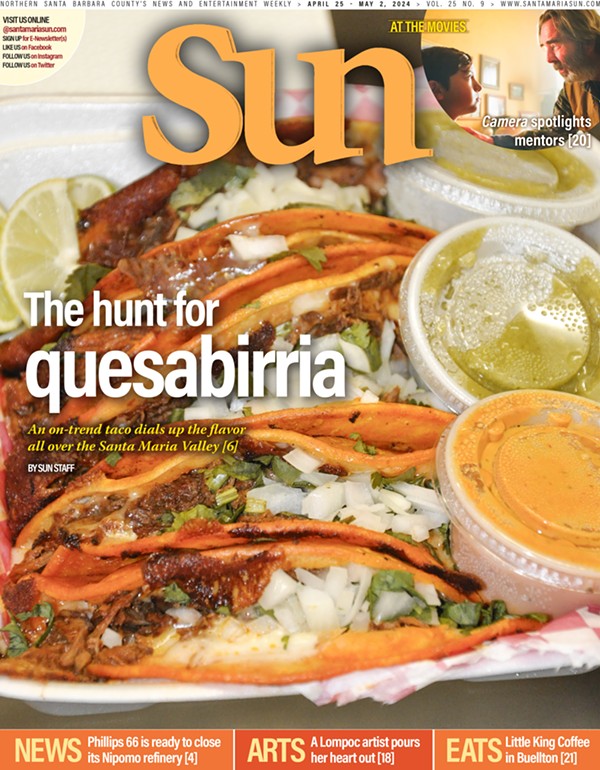With the help of nearly $5 million in federal funding, a Santa Barbara County elderberry farming experiment kicked off in November, aiming to make the locally grown medicinal plant more widely available on the West Coast.
Spearheaded by the White Buffalo Land Trust, a regenerative farming-focused nonprofit founded in Summerland five years ago, the project will explore how to best propagate and cultivate blue elderberry on a handful of small Central Coast farms.
On the chilly morning of Nov. 3, the sun was just starting to light up the delicate green and blush leaves of an elderberry sapling, less than 24 hours after the first plants for the project went into the earth at Jalama Canyon Ranch. The White Buffalo Land Trust bought the 1,400-acre property in April 2022, and this small elderberry planting is the trust’s inaugural farming endeavor on the property.
Featuring about 100 plants, this site will serve as the entire project’s demonstration orchard, showing others how best to grow the plant. They’ll be testing seed-based saplings—like most of these initial plants—as well as vegetative cuttings of wild elderberry, like the highly productive shrub that sits in the creek bed a few yards away.
“The economic lens and ecological lens hit the sweet spot on this project,” explains Ana Smith, who lives at the ranch and runs White Buffalo’s daily operations with her husband, Jesse Smith. “We already have more requests coming in to take part.”
The tart, tiny fruits are loaded with illness-fighting nutrients, according to indigenous knowledge—and modern science has revealed elderberry’s effectiveness in boosting the immune system, treating skin conditions, and enhancing the biodiversity of ecosystems. The global elderberry wellness supplement market alone exceeded $1 billion in sales in 2023—the pandemic triggered a significant, sustained bump—and the sales numbers are expected to nearly triple in a decade, according to Future Market Insights.
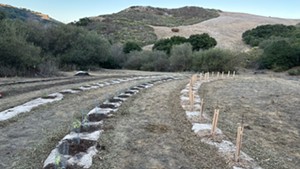
Given California’s recurrent droughts, Jesse is particularly fired up about elderberry’s ability to survive in the driest of times.
“If a grower was to implement irrigation and then found that they had to drastically reduce it, the elderberry would not die,” said Jesse. “You can’t say the same about avocado or coffee or wine grapes or a lot of other things. This is the closest crop that you’re gonna find to a weed.”
Though November marked the project’s first earth-turning, the paper-pushing started a year-and-a-half earlier, when the White Buffalo team applied for a U.S. Department of Agriculture (USDA) grant that focused on climate-smart commodities. Of the 140 grants eventually awarded across the country, many dealt with composting and other accepted strategies for large-scale commodities like soy, grain, dairy, and livestock.
“Very few focused on perennial tree crops,” explained Jesse of their elderberry application. “We are definitely part of a distinct minority.”
That’s one reason why, this past spring, the USDA’s undersecretary personally delivered the $4.6 million check to White Buffalo in a small presentation with state and regional resource managers in attendance. The local enterprise was one of only seven grantees nationwide to get such direct attention.
“They were very excited about the fact that we already had partnerships and relationships in place,” said Jesse, who’s been a leader in eco-minded farming around the region since co-founding Casitas Valley Farm in 2012.
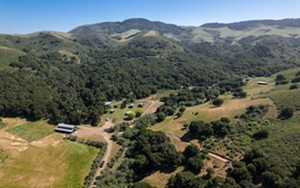
In addition to the demonstration orchard at Jalama Canyon Ranch and two spots at Restoration Oaks Ranch—one in the existing blueberry field, the other on denuded land near the oak nursery—the farming partners are Orella Ranch, known for raising heritage pigs, chickens, and cattle on the Gaviota Coast; Chamberlin Ranch, which is a leader in carbon sequestration on cattle pastures in the Santa Ynez Valley; and the Santa Ynez Band of the Chumash, whose Camp 4 property will house the elderberry nursery.
Though those initial partners are based in Santa Barbara County, the grant’s geographic scope actually extends from Los Angeles to Monterey counties, so other farms may get involved down the road. The goal is for every initial property to plant their elderberries by next spring or fall, with commercial-sized harvests starting in 2025.
But the project is looking at more than farming: “If you don’t have a place to take raw goods and give them a cursory processing, then you’re never gonna be able to develop a market for producers,” Jesse explained. “That was a major component of this project: funding the development of a regional processing facility.”
That facility, the Jungle Beverage Company, is tucked into the back of a nondescript office/warehouse district just north of the Santa Maria Airport. Jim Crooks was there that same November day trying to prepare a mostly empty, 4,500-square-foot building for an upcoming food safety inspection.
Crooks was a brewmaster for Firestone Walker until he left in 2022. There, he developed the Barrelworks brand that thrived on using native plants, like elderberry, in sour beers. He also made a chocolate-orange beer, which came from meeting Mike Orlando, the marine biologist-turned-chocolate-producer who owns Twenty-Four Blackbirds in Santa Barbara.
They combined their business acumen to create Jungle Beverage, a co-manufacturing company, which means they help other companies develop products and then keg/can/package them. They expect to be hired to create or just package a range of products, like vitamin waters, carbonated juices, and caffeinated or alcoholic drinks from this Santa Maria space by sometime next year.
When their mutual friend Jesse Smith explained the elderberry project to Orlando and Crooks, they realized it could eventually be a part of their business model and agreed to collaborate.
“I never considered native plants as stuff you get in our supermarket,” said Orlando, who had gathered elderberries in junior college for the botany lab. “Why are we not doing that? It’s so environmentally friendly to use natives that it’s mind-boggling that they’re not more common.”
At the same time, they recognize the hurdles to come.
“There are not a lot of blueprints on what to do with sorting elderberries,” said Crooks, but he’s ready to learn. “I’m all about process. I have been since the beginning. You just have to embrace it.”
Once the destemming, sorting, and cleaning issues are managed, the possibilities for future products are seemingly unlimited. Frozen berries could be sold to larger elderberry product outfits, for instance, or they could make a line of syrups, seltzers, or even alcoholic beverages at Jungle. They’ll likely do a bit of everything to start.
When it comes to big-picture potential, few people have thought about the commercial viability of blue elderberry more than Sonja Brigitte Brodt at UC Davis. As the associate director of the University of California’s Sustainable Agriculture Research and Education Program, she studied blue elderberry hedgerows in Yolo and Solano counties from 2017 to 2020, confirming that the species possesses similar nutritional traits to the commercial black elderberry and could theoretically become part of that global market.
Her primary concern is whether, once established, California elderberry growers would be able to get the price they need to make a living considering the array of cheaper products on the market.
“How do you explain the whole story of how it’s being grown and what the value of it is in the natural ecosystems and hopefully create a price that’s equitable on both sides?” she asked. “I’m hoping the White Buffalo Land Trust project can make some strides in how to market that.”
Reach Sun contributor Matt Kettman by emailing [email protected]. Find the rest of the story at independent.com/elderberry.


